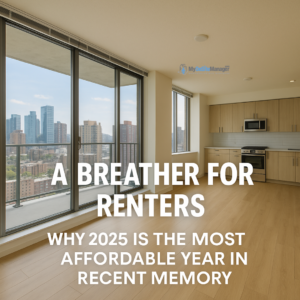After years of relentless rent hikes and economic uncertainty, 2025 is finally bringing a much-needed shift for millions of renters across the United States. A new report reveals that rental affordability has improved to its best level in three years, thanks to moderating rent growth, increasing incomes, and an influx of new housing supply.
For many households that have felt squeezed since the pandemic, this change marks a rare moment of relief and a sign that the rental market is slowly stabilizing.
Rental Affordability Hits a Three-Year High
In December 2024, the median monthly rent stood at approximately $1,592, down slightly from its peak in 2023. To afford this comfortably following the industry’s standard of spending no more than 30% of income on housing households needed to earn about $63,680 annually.
This figure represents a notable improvement from previous years, when incomes were lagging behind soaring rents. In 2025, the wage growth trajectory has finally caught up with and in some markets, surpassed rental costs.
-
Median rent: $1,592/month
-
Annual income needed: $63,680
-
Rent growth YTD: 0.4% (a significant slowdown compared to previous years)
-
National trend: Income growth is outpacing rent increases in many metro areas.
This cooling effect is offering renters the ability to save more, reduce housing cost burdens, and gain financial breathing room.
Key Drivers Behind the Shift
1. New Housing Supply Flooding the Market
One of the biggest factors driving improved affordability is the surge of new multifamily housing developments across the country. Developers who started large projects during the 2021–2022 building boom are finally delivering units, creating more competition and easing upward pressure on prices.
Notably, these new units are not just concentrated in luxury segments; many cities are also seeing growth in mid-range and older apartment stock, which tend to offer more affordable rent levels.
-
Older buildings are experiencing downward rent pressure as newer units come online.
-
Mid-sized markets such as Dallas, Austin, and Phoenix are seeing the strongest affordability improvements.
-
Even some larger cities are benefiting as renters gain more options.
2. Wage Growth Catching Up
Unlike previous years when wages stagnated, median household incomes have increased steadily, helping renters better manage monthly costs. This economic shift is particularly visible in states with strong job markets and expanding industries.
-
More households are now spending less than 30% of their income on rent, which is the recommended affordability threshold.
-
Cities with robust employment growth are also seeing renters move from high-cost to mid-tier housing options.
3. High Homeownership Costs Keeping Renters in Place
Ironically, the continued unaffordability of homeownership is also contributing to rent stabilization. With mortgage rates remaining elevated and housing prices still climbing, many would-be homebuyers are staying renters longer.
This has led to longer lease terms, slower turnover rates, and less upward pressure on asking rents especially in competitive urban markets.
Regional Variations: Where Renters Are Winning
While the national numbers show overall progress, rental affordability still varies significantly by region.
-
More affordable metros: Austin, Dallas, Houston, and parts of the Midwest are seeing strong income-to-rent ratios, giving renters more flexibility and financial security.
-
Challenging markets: High-demand coastal metros such as Miami, New York, San Francisco, and Providence remain outliers, where rental prices still outpace income growth.
-
Stabilizing markets: Cities that experienced explosive rent growth during the pandemic are now seeing stabilization or slight declines, especially in Sunbelt states.
This regional divergence highlights the importance of local housing policies, supply pipelines, and economic conditions in shaping affordability trends.
What This Means for Renters
For renters, this cooling trend represents a window of opportunity. With rent growth slowing, there’s more room to:
-
Negotiate better lease terms or rent concessions
-
Lock in rates before the market potentially shifts again
-
Build savings or allocate funds toward future homeownership goals
-
Explore moving to new neighborhoods or upgraded units without the same cost pressure as before
It’s also an ideal time for renters to plan long-term housing strategies whether that means staying put for stability or exploring more favorable markets.
Implications for Policymakers and Developers
This affordability uptick offers policymakers valuable insights:
-
Encourage new construction to keep supply flowing.
-
Prioritize affordability initiatives so the benefits reach low- and middle-income households.
-
Streamline permitting and reduce regulatory barriers to ensure timely delivery of new housing.
-
Invest in infrastructure and transit to support expanding housing markets.
Developers, meanwhile, can benefit by targeting mid-range rental segments, where demand remains strong but pricing pressure has eased.
A Word of Caution: Challenges Remain
Despite this progress, not all renters are out of the woods. Many lower-income households still spend a disproportionate share of their income on rent, particularly in urban cores with persistent affordability gaps.
-
The lowest-income households are most vulnerable to market fluctuations.
-
Housing cost burdens continue to weigh heavily on essential workers, seniors, and young renters.
-
Without sustained supply and affordability policies, this progress could stall or reverse.
This is why housing experts emphasize the need to treat this as a moment to build momentum, not a sign that the affordability crisis is over.
The Bottom Line
The U.S. rental market in 2025 looks very different from just a few years ago. Instead of double-digit rent hikes and bidding wars, many renters are finally experiencing stability even relief.
With more housing units hitting the market, wages on the rise, and rent growth moderating, this is shaping up to be the most renter-friendly landscape in recent memory.
But to sustain and expand this progress, strong policy support and steady construction activity are essential. Renters, landlords, and policymakers alike have a chance to reshape the future of affordable housing.
Source: MSN News

